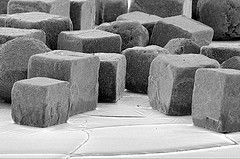|
Grade 3 Science Unit 2- Do You See What I See? |
 |
Essential Question: How can we justify the classification of objects based on their observable features, including objects that are too small to see.? |
|
| Enduring Understandings | Resources |
|
Students will use Kidspiration to brainstorm verbs that describe the classroom. Students will add more examples during classroom discussion. (If the link does not open, login to aacps.discoveryeducation.com) (If the link does not open, login to aacps.discoveryeducation.com)
(If the link does not open, login to aacps.discoveryeducation.com) Structure of Matter Describing properties, mass, volume, physical and chemical changes.
Your Weight on Other Worlds Students will identify the relationship between mass and weight (Extension).
(If the link does not open, login to aacps.discoveryeducation.com) (If the link does not open, login to aacps.discoveryeducation.com) (If the link does not open, login to aacps.discoveryeducation.com) (If the link does not open, login to aacps.discoveryeducation.com)
States of Matter Activtity
Visit this link, then have students log into
Kidspiration
|
| Scientific tools can be used to see objects and features that cannot
be seen by the unaided eye. The students will identify and describe structures of objects too small to be seen with the unaided eye by using a hand lens. |
Students will create a Trading Card to go along with the Careers in Science: Benjamin S. Carson, M.D.
Virtual Electron Microscope This microscope has students determine how a microscope can help scientists by looking at different specimens.
Microscope Images This website gives a variety of magnified images of common items for students to observe.
How to Use a Microscope Step by step instruction on how to use a microscope.
|
| Required Lab: Through the Lens |
Resources |
|
Students will conduct an experiment to answer the question "How do you recognize and describe matter by using a magnification tool?" |
|
| Project: Zoom In! A Magnification Mode |
Resources |
| Students will create models of magnified objects in order to demonstrate its minute features. |
Possible
Resources for Student Research: Consult with media specialists
for online database resources and books
|
| Unit Resources | |
| Curriculum Links | Resources |
|
Readings, Lesson Plans, SMARTboard Lessons, and Websites |
|
| Teacher Notes | |
| Standards | Resources |
|
Content Standard:
4.A.1.a Classify objects based on their observable properties
5.A.1.a Select relevant information from technology resources. 6.0: Students will use technology and develop strategies to solve problems and make informed decisions. |
Describe Our Classroom What's Your Property? 5E Lesson Plan Grouping and Changing Materials Structure of Matter Solids, Liquids and Gases Take Up Space Solids, Liquids and Gases (Study Jams)
Properties of Matter
(If the link does not open, login to aacps.discoveryeducation.com) |
|
Content Standard: 4.A.1.b Provide reasons for placing objects into groups.
5.A.1.a Select relevant information from technology resources. 6.0: Students will use technology and develop strategies to solve problems and make informed decisions. |
|
|
Content Standard:
4.A.1.c
Compare classifications with those of others. Technology Standard: 5.A.1.a Select relevant information from technology resources. 6.0: Students will use technology and develop strategies to solve problems and make informed decisions. |
Where Do I Belong? Real World Reading: "Classifying Katrina" Abra-Cadabra!
(If the link does not open, login to aacps.discoveryeducation.com) |
|
Content Standard:
4.A.2.a
Identify and describe minute objects, such as grains of sand and crystals of salt afte examining them with a magnifying instrument. Technology Standard: 5.A.1.a Select relevant information from technology resources. 6.0: Students will use technology and develop strategies to solve problems and make informed decisions. |
Real World Reading: "History of the Microscope" Ben Carson Trading Card Careers in Science: Benjamin S. Carson, M.D. Kosher Salt Virtual Electron Microscope How to Use a Microscope |
|
Content Standard:
4.A.2.b Identify and describe the minute features of objects, such as the lines (grain) in a piece of wood and the fibers of a paper napkin after examining with a magnifying instrument. Technology Standard: 5.A.1.a Select relevant information from technology resources. 6.0: Students will use technology and develop strategies to solve problems and make informed decisions. |
Up Close and Personal Magnifying Fabric Worksheet Microscope Images |
August 2015